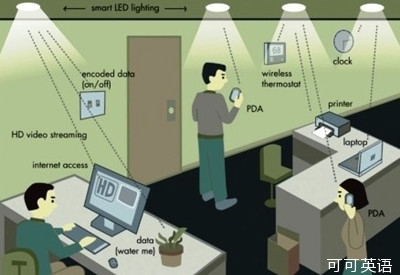Here's a bright idea: instead of radio waves, use light to get online.
妙点子的原理是这样的:不利用无线电波,而是利用光线来上网。
Unlike wi-fi, or wireless fidelity, so-called “li-fi” transmits data through variations in light intensity.
与wi-fi,或熟知的无线保真不同,所谓的li-fi通过光强度的变化传输数据。
Researchers in China recently showed that, using a one-watt LED bulb, li-fi could connect four computers to the Internet at data transfer rates up to 150 megabits per second.
最近中国的研究者们发现,使用一个1瓦特的LED灯泡,li-fi就可以以带宽150兆/秒的传输速率连接4台电脑接入互联网。
 Earlier this year, German scientists sent data at three Gigabits per second using LED lamps, in controlled conditions in their lab.
Earlier this year, German scientists sent data at three Gigabits per second using LED lamps, in controlled conditions in their lab.
今年早些时候,德国科学家在他们的实验室中特定条件下使用LED灯以每秒3吉位的速度发送数据。
They later demonstrated 500 megabits per second speeds in a real-world setting.
而后他们在现实生活环境中展现了500兆/秒的速度。
Most wi-fi connections don't even come close to 100 megabits per second.
然而大多数的wi-fi连接甚至达不到100 兆/秒。
Li-fi has drawbacks.
同样li-fi也有缺点。
The technology works only when the LED's light can reach the gadget.
这项技术只能仰仗LED这个小装置的光源。
Stray from the LED, and you lose your connection.
没有了LED,你就会失去一切联系。
On the plus side, the visible light spectrum can handle way more traffic than wi-fi's already crowded radio spectrum.
另外, 相比wi-fi拥挤的无线电频谱,可见光谱可以应对更多的传输方式。
And any LED bulb can be a network connection.
而且任何的LED灯泡都可以是一个网络连接。
We may someday look back at wi-fi as technology from the dark ages.
我们总有一天会追忆来自于黑暗时代wi-fi技术。
 Earlier this year, German scientists sent data at three Gigabits per second using LED lamps, in controlled conditions in their lab.
Earlier this year, German scientists sent data at three Gigabits per second using LED lamps, in controlled conditions in their lab. Earlier this year, German scientists sent data at three Gigabits per second using LED lamps, in controlled conditions in their lab.
Earlier this year, German scientists sent data at three Gigabits per second using LED lamps, in controlled conditions in their lab.